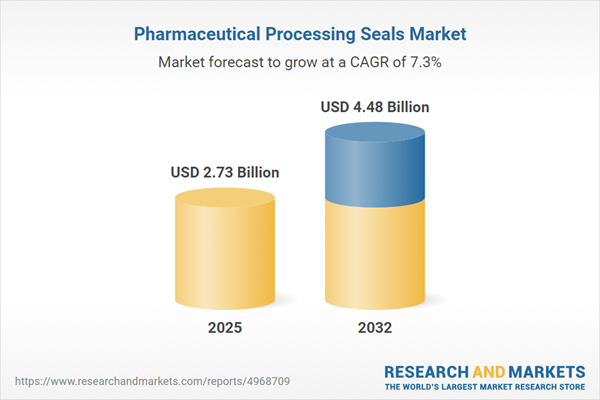Speak directly to the analyst to clarify any post sales queries you may have.
The pharmaceutical processing seals market is fundamental to pharmaceutical manufacturing, supporting product purity and efficient operations amid evolving industry standards. As pressure mounts to safeguard quality and streamline processes, advanced seal solutions prove essential for meeting compliance, minimizing contamination, and assuring reliable production outcomes.
Market Snapshot: Pharmaceutical Processing Seals Market Size and Growth
The pharmaceutical processing seals market grew from USD 2.54 billion in 2024 to USD 2.73 billion in 2025, with expectations to reach USD 4.48 billion by 2032 at a CAGR of 7.34%. This robust growth trajectory reflects increasing demand for advanced, contamination-resistant sealing products in pharmaceutical and biopharmaceutical manufacturing. Senior decision-makers face rising expectations to support production scaling, address regulatory scrutiny, and ensure asset reliability across global supply chains.
Scope & Segmentation
This comprehensive report analyzes key segments, regional dynamics, and technological advancements shaping the pharmaceutical processing seals landscape. Segment coverage includes:
- Seal Types: Cartridge (balanced and unbalanced), diaphragm (elastomeric and metallic), compression gaskets, spiral wound, mechanical (single and double), O rings (pharma grade and standard)
- Material Types: EPDM (standard and modified), fluoroelastomers (FEP and FKM), PTFE (filled and virgin), silicone (HTV and LSR), various metal alloys and stainless steel
- Applications: API processing (crystallization, reaction vessels), biopharmaceutical cell culture, fermentation, fill-finish, bulk chemical storage and transfer, packaging (blister, bottling), sterile formulation (aseptic filling, lyophilization)
- End Users: Large and small biotechnology firms, pharmaceutical innovators and generics companies, contract manufacturers (full service and specialty), research institutes (academic, government)
- Equipment Types: Compressor (dry gas, oil-lubricated), pump (centrifugal, positive displacement), reactor (agitator, jacketed vessel), tank (manway, sight glass), valve (ball and diaphragm)
- Distribution Channels: Direct sales (aftermarket, OEM), distributors (industrial, specialized), and online platforms (manufacturer sites, third-party e-commerce)
- Regions: Americas (North America, Latin America), Europe, Middle East & Africa, Asia-Pacific
- Leading Companies: Freudenberg Sealing Technologies, Trelleborg AB, Flowserve Corporation, Parker-Hannifin Corporation, Smiths Group, EnPro Industries, Baker Hughes, IDEX Corporation, Crane Co.
Key Takeaways for Decision-Makers
- Pharmaceutical processing seals underpin product integrity and are central to risk mitigation, supporting seamless compliance and operational performance.
- Material innovations, such as advanced fluoroelastomers and high-purity PTFE, enable robust chemical compatibility across complex manufacturing environments.
- The rapid adoption of digital technologies and additive manufacturing facilitates predictive maintenance, accelerates prototyping, and optimizes lifecycle management for critical equipment.
- Regional demand varies, with Asia-Pacific leading continuous manufacturing investments, the Americas emphasizing reliability and certification, and Europe focusing on environmental compliance.
- Collaboration across OEMs, seal manufacturers, and research centers accelerates next-generation sealing solutions tailored for evolving process technologies, including single-use and aseptic systems.
Tariff Impact on Costs and Supply Chain Strategy
The introduction of new United States tariffs in 2025 has added cost pressures for imported seal components and specialty raw materials. These tariffs affect procurement expenses and require senior executives to reassess supplier diversification, inventory management, and dual-sourcing agreements. Strategic responses include collaborating with domestic polymer producers, establishing inventory buffers, and leveraging comprehensive cost analyses to balance quality and risk across the supply chain.
Methodology & Data Sources
Research findings combine in-depth primary interviews with pharmaceutical executives, engineers, and procurement specialists, reinforced by secondary analysis across regulatory documents, technical publications, and industry databases. Stringent validation processes, including cross-referencing company reports and triangulating qualitative and quantitative inputs, underpin credible forecasts for the pharmaceutical processing seals market.
Why This Report Matters
- Provides clear, actionable segmentation analysis to align business development, R&D, and procurement strategies with current and emerging industry needs.
- Equips stakeholders with tangible recommendations for operational resilience, cost containment, and supplier engagement—especially within new tariff landscapes.
- Delivers reliable benchmarking and competitive intelligence to support informed capital investment and product innovation decisions.
Conclusion
The pharmaceutical processing seals market is evolving rapidly, shaped by innovation, regulation, and supply chain shifts. This report empowers senior leaders to make strategic, forward-looking decisions, supporting safe and efficient pharmaceutical manufacturing worldwide.
Additional Product Information:
- Purchase of this report includes 1 year online access with quarterly updates.
- This report can be updated on request. Please contact our Customer Experience team using the Ask a Question widget on our website.
Table of Contents
3. Executive Summary
4. Market Overview
7. Cumulative Impact of Artificial Intelligence 2025
Companies Mentioned
The companies profiled in this Pharmaceutical Processing Seals market report include:- Freudenberg Sealing Technologies GmbH & Co. KG
- Trelleborg AB
- Flowserve Corporation
- Parker-Hannifin Corporation
- Smiths Group plc
- EnPro Industries, Inc.
- Baker Hughes Company
- IDEX Corporation
- Crane Co.
- Flowserve Corporation
Table Information
| Report Attribute | Details |
|---|---|
| No. of Pages | 195 |
| Published | October 2025 |
| Forecast Period | 2025 - 2032 |
| Estimated Market Value ( USD | $ 2.73 Billion |
| Forecasted Market Value ( USD | $ 4.48 Billion |
| Compound Annual Growth Rate | 7.3% |
| Regions Covered | Global |
| No. of Companies Mentioned | 11 |









